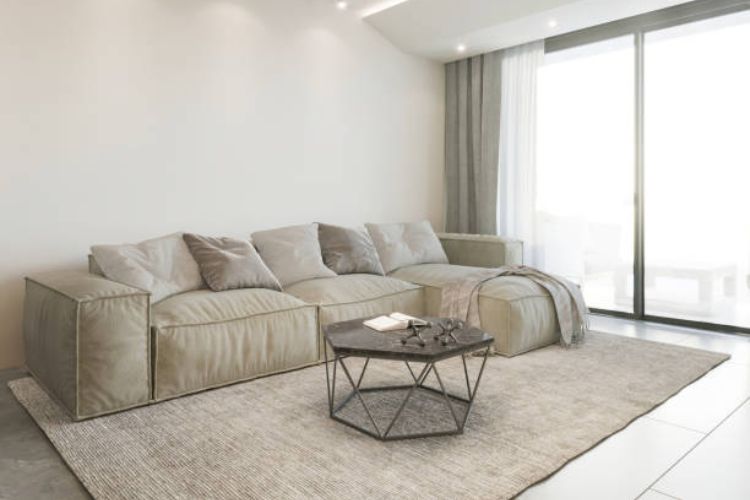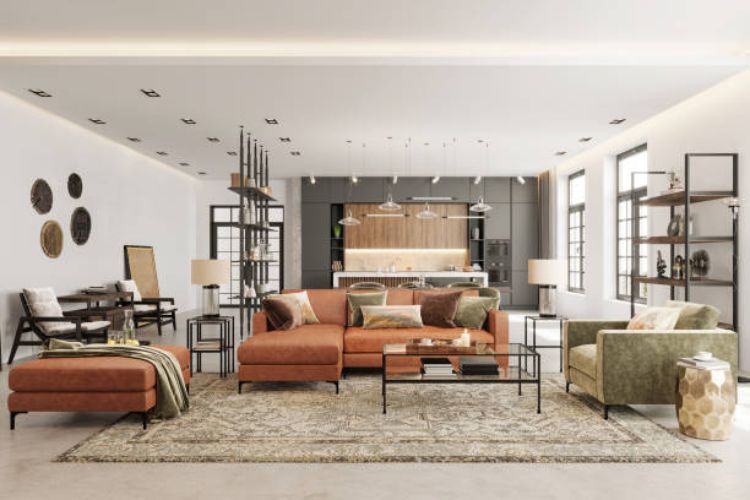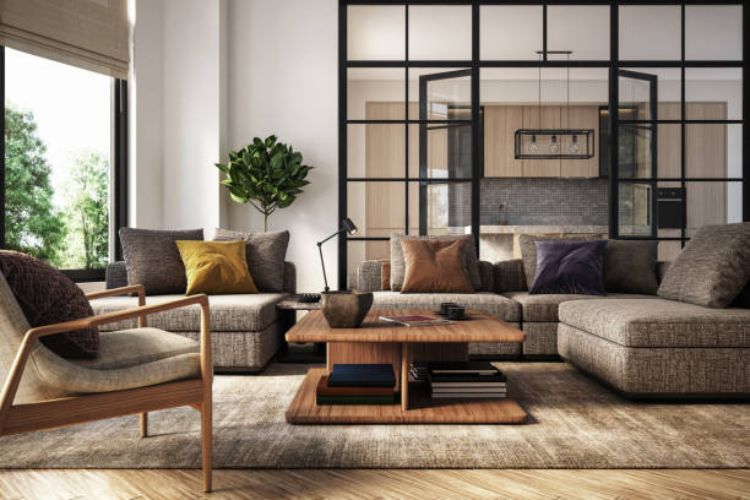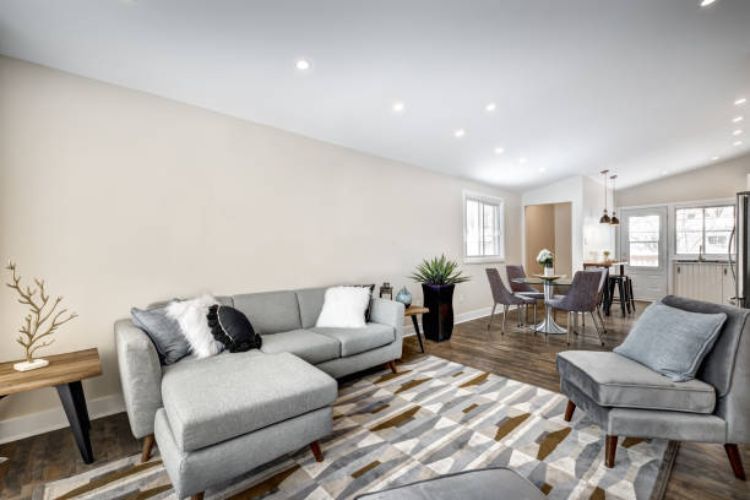Creating an inviting living space starts with a carefully thought-out seating arrangement. When you add a sectional sofa to the mix, it can be tricky to find the ideal placement that works with your floor plan.

To make sure your entire sectional fits comfortably and looks stylish, follow these tips to place your rug under the sofa correctly. With these simple steps, you’ll be able to create a cozy environment that puts your sectional in center stage.
Why you should place a rug under a sectional sofa?
There are several reasons to place a rug under a sectional sofa. I have pointed out 10. They are as follows.

1. Rugs help anchor furniture:
Placing a rug under a sectional sofa helps anchor the furniture and define the seating area, creating a visual focal point in the room. This can help to make the space feel more cohesive and put together.
2. Rugs protect the floor:
A rug can help to protect the floor underneath the sectional sofa from scratches, dents, and general wear and tear. This is especially important if you have hardwood or laminate flooring that is susceptible to damage.
3. Rugs can make rooms special:
Rugs can add texture and depth to a room, enhancing the overall aesthetic and style. By choosing a rug that complements the sectional sofa and other elements in the space, you can elevate the overall design and create a more visually appealing environment.
4. Rugs can be used to absorb sound:
Having a rug under the sectional sofa can also help with sound absorption in the room, reducing echoes and making the space feel more acoustically pleasant. This is particularly beneficial if you have hard flooring surfaces that tend to amplify sound.
5. Rugs can be comfortable under the feet:
A rug can provide a soft and comfortable surface for your feet when seated on the sectional sofa. This can make the seating area more inviting and cozy, especially during colder months.
6. Rugs can separate furniture areas:
Placing a rug under the sectional sofa can help to visually separate the seating area from the rest of the room, creating a defined space for relaxation and conversation. This can contribute to a more functional and organized living space.
7. Rugs can add warmth and isolation:
Rugs can also help to add warmth and insulation to a room, particularly if you have tiled or concrete flooring. This can be especially beneficial during colder seasons, as the rug can help to trap heat and keep the space feeling cozy.
8. Rugs can create a sense of scale:
If you have an open floor plan or a large room, a rug under the sectional sofa can help to create a sense of scale and proportion. By visually grounding the furniture, the rug can help to balance the overall layout and make the space feel more balanced and harmonious.
9. Rugs can act as a visual barrier:
A rug can act as a visual barrier, preventing the sectional sofa from sliding or shifting on smooth flooring surfaces. This can help to keep the furniture in place and reduce the risk of accidents or injuries.
10. Rugs can make cleaning easier:
Placing a rug under a sectional sofa can make cleaning and maintenance easier. The rug can help to catch dirt, dust, and debris that may otherwise accumulate on the floor, making it easier to keep the space clean and tidy.
Overview of rug placement process under a sectional
When it comes to rug placement under a sectional, there are a few key points to consider. Here is an overview of the rug placement process:

| Key points | Explanation |
| 1. Determine the ideal size: | Measure the dimensions of your sectional to determine the appropriate size for the rug. Ideally, the rug should be large enough to accommodate the entire sectional or at least the front legs of the furniture. |
| 2. Shape and orientation: | Consider the shape and orientation of your sectional. If it is an L-shaped sectional, you may opt for an area rug that follows the shape of the furniture. For a U-shaped sectional, a round or square rug can work well. |
| 3. Define the seating area: | Place the rug in a way that defines the seating area. The rug should extend beyond the edges of the sectional to create a cohesive and visually appealing look. This helps to anchor the furniture and create a designated space. |
| 4. Centering the rug: | Position the rug in the center of the seating area. This helps to balance the space and creates a visually pleasing arrangement. Ensure that the rug is aligned with the other furniture pieces in the room, such as coffee tables or side tables. |
| 5. Consider the surrounding furniture: | Take into account any other furniture pieces in the room and how they interact with the sectional. If there are additional chairs or tables, make sure they are partially or fully on the rug to create a cohesive design. |
| 6. Take room size into consideration: | The size of the room should also be considered when placing a rug under a sectional. If the room is small, a large rug may overwhelm the space. Opt for a smaller rug that still allows the furniture to be anchored. |
| 7. Personal preference: | The placement of the rug under a sectional is a matter of personal preference. Experiment with different options and arrangements to find the placement that works best for your space and aesthetic. |
Note: Remember, the goal is to create a harmonious and visually pleasing arrangement that complements your sectional and overall room design.
Factors to consider placing a rug under a sectional sofa
There are several factors to consider before placing a rug under a sectional sofa. They are as follows.

| Factors | Explanation |
| 1. Size and Proportion: | Consider the size and shape of the rug in relation to the sectional sofa. The rug should be large enough to accommodate the entire seating area of the sectional, extending beyond the edges of the sofa to create a cohesive and balanced look. |
| 2. Style and Design: | Choose a rug that complements the style and design of the sectional sofa. Consider the color, pattern, and texture of the rug to ensure it enhances the overall aesthetic of the space. |
| 3. Functionality: | Determine the purpose of the rug under the sectional sofa. It can help define and anchor the seating area, protect the flooring from scratches or stains caused by the sofa, or provide additional comfort and warmth underfoot. |
| 4. Traffic and Durability: | Take into account the level of foot traffic in the area where the sectional sofa is placed. Consider a rug material that is durable and easy to clean, especially if it will be exposed to high levels of activity or if you have children or pets. |
| 5. Maintenance: | Consider the maintenance requirements of the rug. Some rugs may require regular vacuuming, professional cleaning, or spot cleaning. Choose a rug that fits your lifestyle and maintenance preferences. |
| 6. Budget: | Determine your budget for the rug. Rugs come in a wide range of prices, so consider what you are willing to spend and find a rug that meets your budget without compromising on quality or style. |
| 7. Personal Preference: | Consider your personal preference and the overall look and feel you want to achieve in the space. Choose a rug that you love and that adds to the overall comfort and aesthetic appeal of your sectional sofa area. |
Selecting the Right Rug Size
Before selecting the right rug size, you must know some tips to perfectly choose one. Follow the below tips to go through the process easily.

| Tips | Explanation |
| 1. Measure the area where you plan to place the rug: | Use a tape measure to determine the length and width of the space to ensure you select a rug that fits properly. |
| 2. Consider the furniture layout: | If you have furniture in the space, such as a dining table or sofa, take into account how the rug will interact with the furniture. Make sure the rug is large enough to accommodate all the furniture legs or at least the front legs. |
| 3. Determine the purpose of the rug: | Are you looking for a rug to define a specific area, such as a sitting area or dining area? Or do you want a rug that covers the entire floor? The purpose of the rug will help determine the appropriate size. |
| 4. Leave some space around the rug: | It’s generally recommended to leave about 18 inches of bare floor between the edge of the rug and the walls. This helps create a balanced and visually appealing look. |
| 5. Consider the shape of the rug | Depending on the shape of the space, you may want to choose a rug that complements the shape. For example, a round rug may work well in a circular dining area, while a rectangular rug may be better suited for a long hallway. |
| 6. Take into account the style of the room: | The size of the rug can impact the overall aesthetic of the room. A larger rug can make a space feel more cozy and intimate, while a smaller rug can create a more open and spacious feel. Choose a size that complements the style and scale of the room. |
| 7. Consider the traffic flow: | If the area where you plan to place the rug has heavy foot traffic, it’s important to choose a rug size that can withstand wear and tear. Opt for a larger rug that covers the majority of the space to ensure durability. |
| 8. Seek professional advice: | If you’re unsure about the right rug size for your space, consider consulting with an interior designer or rug specialist. They can provide expert guidance and help you select the perfect size for your needs. |
Standard Rug Sizes
Standard rug sizes are essential to consider when purchasing a rug for your home or office. These predetermined sizes ensure that you can find a rug that fits perfectly in your desired space. Common standard rug sizes include small options like 2’x3′, 3’x5′, and 4’x6′, which are suitable for entryways, bathrooms, or small seating areas.
Medium sizes, such as 5’x8′, 6’x9′, and 8’x10′, are ideal for living rooms, dining rooms, and bedrooms. Larger sizes like 9’x12′ or 10’x14′ are suitable for more expansive areas such as open-concept living spaces or grand rooms. By understanding standard rug sizes, you can effortlessly select a rug that complements your space, enhances the overall design, and provides comfort underfoot.
What size rug for an L-shaped sectional?
The size of the rug for an L-shaped sectional will depend on the specific dimensions of the sectional and the overall layout of the room. However, as a general guideline, it is recommended to choose a rug that is large enough to anchor the entire seating area, including the L-shaped sectional and any additional furniture.
This helps to create a cohesive and visually appealing space. Ideally, the rug should extend beyond the edges of the sectional, allowing for easy movement and creating a sense of balance in the room.
What size rug for a U-shaped sectional?
The size of the rug for a U-shaped sectional will depend on the dimensions of the sectional and the layout of the room. Generally, it is recommended to choose a rug that is large enough to fit under all legs of the sectional, including the chaise if there is one. This helps to visually anchor the sectional and define the seating area.
The rug should extend beyond the edges of the sectional to create a cohesive and balanced look. Additionally, the rug size should take into consideration the scale of the room and other furniture pieces in the space.
What size rug for a sectional couch with a chaise?
The size of the rug for a sectional couch with a chaise will depend on the layout and dimensions of the room. Generally, it is recommended to choose a rug that is large enough to fit the entire sectional couch and chaise on top of it, ensuring that the furniture is fully placed on the rug.
This helps to create unity and define the seating area, making the space feel more cohesive and visually appealing. Having a larger rug can also provide more comfort and cushioning underfoot when sitting or walking around the sectional couch.
Entire Sectional Sofa Measurement
When measuring a rug for a standard-sized sectional sofa, you should consider the overall dimensions of the sectional. Start by measuring the length and width of the entire sectional, including any extended chaise or ottoman. This will give you the minimum size of the rug needed to cover the entire seating area.
Consider leaving some extra space around the sectional to create a visually balanced look. It is recommended to have at least 12-18 inches of rug extending beyond the edges of the sectional. This will help define the seating area and create a cohesive and stylish appearance.
How to place a rug under a sectional sofa (step by step)
Placing a rug under a sectional sofa is quite easy job to do. If you follow the 10 steps you can easily place a rug under a sectional sofa. The steps are as follows.

Step 1- Measure dimensions:
Measure the dimensions of the sectional sofa and the desired area for the rug. Ensure that the rug is large enough to fit completely under the sofa, extending several inches beyond the edges.
Step 2- Clean the place:
Clean the floor where the rug will be placed. Remove any furniture or obstacles from the area to ensure a smooth, clean surface.
Step 3- Position the rug:
Position the rug in the desired location, aligning it with the edges of the sectional sofa. Ensure that the rug is centered and evenly placed.
Step 4- Secure the rug:
Use rug grippers or double-sided carpet tape to secure the rug in place. This will prevent it from shifting or sliding under the weight of the sofa and foot traffic.
Step 5- Adjust the sectionals position:
Adjust the position of the sectional sofa on the rug, making sure it is centered and evenly distributed. Pay attention to the placement of the sofa legs, ensuring they are on the rug and not hanging off the edges.
Step 6- Careful placing over the rug:
Once the rug is properly positioned, carefully place the sectional sofa on top of it. Take care not to damage the rug or cause it to wrinkle or fold.
Step 7- Ensure the visibility of the rug:
Ensure that the rug is visible under the sectional sofa, with a few inches of the rug exposed on all sides. This will create a visually appealing and cohesive look.
Step 8- Regular cleaning:
Regularly clean and maintain the rug and the area under the sectional sofa to keep it looking fresh and tidy. Vacuum the rug regularly and promptly address any spills or stains to prevent permanent damage.
Step 9- Consider using furniture pads:
Consider using furniture pads or sliders under the legs of the sectional sofa to protect the rug from excessive wear and tear.
Step 10- Enjoy the view:
Enjoy your newly placed rug under your sectional sofa! It not only adds visual interest and style to the space but also helps to define the seating area and create a cozy atmosphere.
How to choose a rug for a sectional sofa?
To choose a rug for a sectional sofa, consider the size and shape of the sofa, the size and layout of the room, and the style and color scheme you want to achieve.

Choose a rug that is large enough to fit under the entire sectional, with at least 8-12 inches of rug visible on all sides. It should complement the sofa and other furniture, while also defining the seating area.
Rug placement for sectional with chaise
When it comes to rug placement for a sectional with a chaise, there are a few key considerations.
1. It’s important to choose a rug that is large enough to accommodate both the sectional and the chaise.
2. The rug should extend beyond the sectional and chaise, creating a cohesive and visually balanced look.
3. The rug should be positioned in a way that highlights the seating area, anchoring the furniture and creating a designated space.
4. It’s also important to ensure that the rug is positioned in a way that allows for easy movement around the sectional and chaise.
By taking these factors into account, you can create a stylish and functional rug placement for your sectional with a chaise.
L-shaped couch rug placement
When placing a rug with an L-shaped couch, it is best to position the rug so that it extends beyond the front legs of the couch. This helps to anchor the seating area and create a cohesive visual effect.
The rug should extend far enough to encompass any accompanying furniture pieces, such as a coffee table or side tables, to create a balanced and inviting space.
U-shaped sectional rug placement
Placing a U-shaped sectional rug in your living space can create a cozy and inviting atmosphere while adding a touch of elegance to your home decor. This rug placement is not only aesthetically pleasing but also serves practical purposes.
By positioning the rug in a U-shape around your sectional sofa, you define and anchor the seating area, giving it a sense of structure and organization. This arrangement also helps to visually separate the seating area from the rest of the room, creating a designated space for relaxation and conversation.
Whether you choose a plush and luxurious rug or a more minimalistic design, the U-shaped sectional rug placement enhances the overall ambiance of your living space, making it both visually appealing and comfortable for you and your guests.
Any size rug under a sectional
When it comes to placing a rug under a sectional sofa, size plays a crucial role. Whether you have a small or large sectional, finding the right size rug is important for both aesthetics and functionality. A well-placed rug can anchor the sectional, define the space, and add warmth and texture to the room.
It can also help protect the flooring beneath the sectional. When choosing a rug size, consider the dimensions of your sectional and the room. For a smaller sectional, a 5×7 or 6×9 rug can work well, while a larger sectional may require an 8×10 or 9×12 rug.
The goal is to find a rug that complements the size and shape of your sectional, creating a balanced and cohesive look in your living space.
Conclusion
When placing a rug under a sectional sofa, there are several considerations to keep in mind. The size and shape of the rug should be large enough to accommodate the entire sectional, allowing for all legs of the sofa to rest comfortably on the rug. This helps to create a cohesive and visually appealing look, while also providing a sense of grounding and definition to the seating area.
The rug should be positioned in a way that complements the overall layout and style of the room. By carefully considering these factors, homeowners can create a balanced and inviting space that maximizes both comfort and aesthetics.
FAQs
Frequently Asked Questions
How to measure a rug for a sectional sofa?
To measure a rug for a sectional sofa, start by taking the measurements of the entire sectional. Then, ensure that all legs of the sectional are on the rug to create a cohesive look. The rug should extend beyond the edges of the sectional to define the space. Consider the desired rug placement, such as under the coffee table or centered in the seating area. Lastly, measure the width and length of the rug to ensure it accommodates the sectional’s dimensions.
How to slide a rug under a sectional couch?
To slide a rug under a sectional couch, start by lifting one side of the couch slightly and placing the rug underneath. Then, gently slide the rug towards the other side of the couch, lifting the couch as needed. Repeat this process on the other side of the couch until the rug is in the desired position. Ensure that the rug is centered and aligned properly before lowering the couch back down.
How to put an area rug under a sectional?
To properly position an area rug under a sectional, follow these steps: Measure the dimensions of the sectional and choose a rug size that is large enough to fit all legs of the furniture on top comfortably. Ensure the rug is centered under the sectional, allowing for an equal amount of rug visible on all sides.
Use a rug pad to prevent slipping and add cushioning. If the sectional has a chaise or ottoman, position the rug in a way that accommodates these pieces while maintaining a cohesive look. Adjust the rug as needed to create a visually pleasing arrangement, ensuring that it complements the overall aesthetic of the room.
Leave a Reply